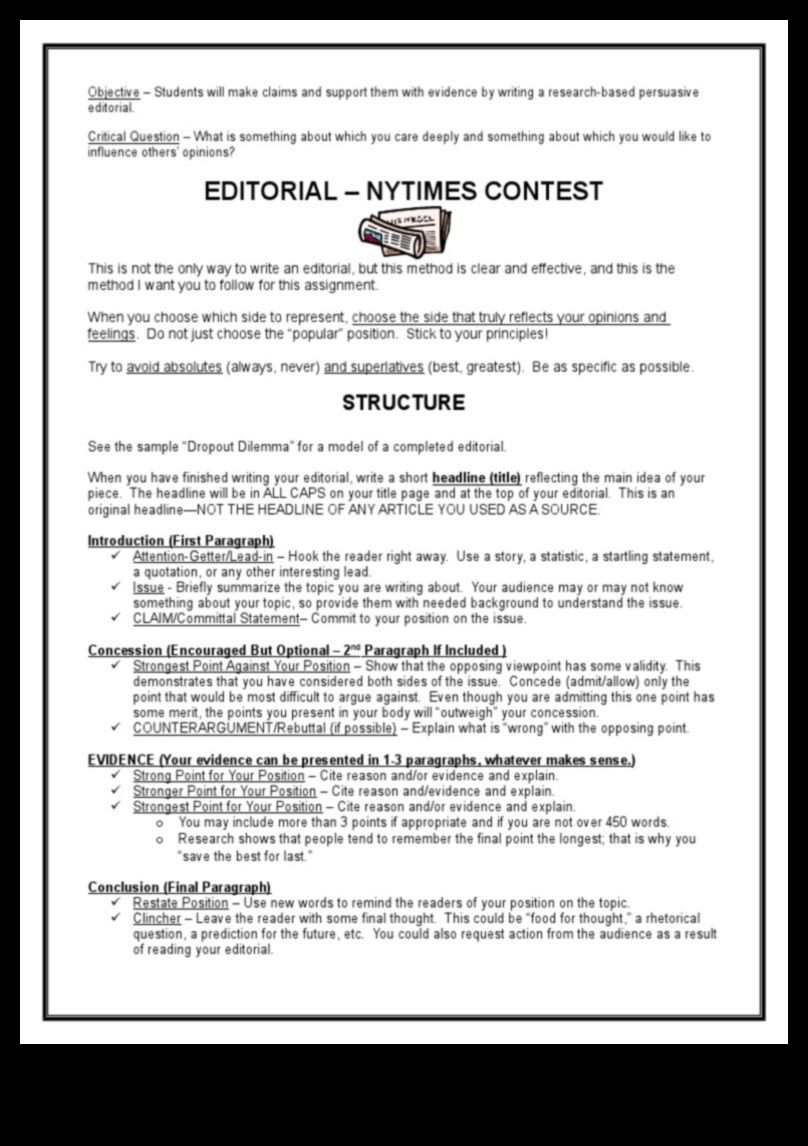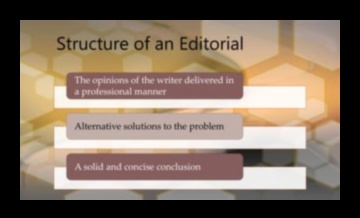
How Should an Editorial Be Structured?
Editorial structure is the framework that organizes an editorial’s content. It helps to ensure that the editorial is well-written, easy to read, and persuasive. An effective editorial structure will:
- Grab the reader’s attention
- Present the argument in a clear and concise way
- Provide evidence to support the argument
- Conclude with a strong call to action
Here are some tips for structuring your editorials:
- Start with a strong hook. This could be a surprising statistic, a personal anecdote, or a thought-provoking question.
- Organize your argument in a logical way. This could be chronological, topical, or by order of importance.
- Support your arguments with evidence. This could include facts, statistics, quotes, and personal experiences.
- Conclude with a strong call to action. This could be asking readers to sign a petition, donate to a cause, or take some other kind of action.
By following these tips, you can create editorials that are engaging, informative, and persuasive.
| Feature | Editorial Structure | Editorial Writing | Writing Style | Article Structure | Writing Tips |
|---|---|---|---|---|---|
| Introduction | How to create an editorial structure for your blog | How to write an effective editorial | How to develop a strong writing style | How to structure your articles | How to improve your writing skills |
| The Importance of Editorial Structure | The elements of a strong editorial calendar | How to use visuals and quotes in your writing | How to make your writing more engaging | How to track the success of your articles | How to optimize your writing for SEO |
| How to Create an Editorial Structure for Your Blog | How to promote your editorial calendar | How to avoid common mistakes in writing | How to write for different audiences | How to write effective headlines | How to write engaging blog posts |
| The Elements of a Strong Editorial Calendar | How to track the success of your editorial calendar | Tips for optimizing your writing for SEO | How to write for different purposes | How to write effective emails | How to write engaging social media posts |
| How to Promote Your Editorial Calendar | Common mistakes to avoid when creating an editorial calendar | Conclusion | FAQ | Conclusion | FAQ |

II. The Importance of Editorial Structure
An editorial structure is important for a number of reasons. First, it can help you to organize your thoughts and ideas. When you know what you want to say and in what order, you can write more effectively and efficiently. Second, an editorial structure can help you to keep your writing on track. It can prevent you from rambling or getting off-topic. Third, an editorial structure can help you to engage your readers. When your writing is well-organized and easy to follow, readers are more likely to stay engaged and read to the end.
How should an editorial be structured?
An editorial is a piece of writing that expresses the opinion of the writer or publication. It is typically written by a staff writer or editor, and it is often published in a newspaper or magazine. Editorials can also be published online.
Editorials are typically written in a persuasive style, and they often use strong language to make their point. They may also include facts and statistics to support the writer’s argument.
The structure of an editorial is typically as follows:
- Introduction
- Body
- Conclusion
The introduction should grab the reader’s attention and introduce the topic of the editorial. The body should provide evidence to support the writer’s argument, and the conclusion should summarize the writer’s main points.
Here are some tips for writing an effective editorial:
- Use strong language to make your point.
- Include facts and statistics to support your argument.
- Be persuasive, but avoid being too opinionated.
- Make sure your editorial is well-written and free of errors.
Writing an editorial can be a great way to share your opinion on a topic that you care about. By following these tips, you can write an editorial that is both informative and persuasive.
IV. The Elements of a Strong Editorial CalendarA strong editorial calendar is essential for any blog or website that wants to publish high-quality content on a consistent basis. The elements of a strong editorial calendar include:
- A clear and concise mission statement
- A well-defined target audience
- A consistent publishing schedule
- A variety of content types
- A strong social media presence
- A commitment to quality
Each of these elements is essential for creating a successful editorial calendar that will help you reach your goals.
By following these tips, you can create an editorial calendar that will help you publish high-quality content on a consistent basis and reach your target audience.

How should an editorial be structured?
An editorial is a written piece that expresses the opinion of an individual or group of people. It is typically published in a newspaper, magazine, or other publication. Editorials are often used to express a point of view on a particular issue or event.
There are a few key elements that should be included in an effective editorial. These include:
- A clear and concise thesis statement
- Supporting evidence to back up the thesis statement
- A strong call to action
In addition, editorials should be written in a clear and concise style that is easy to understand. They should also be free of any grammatical or spelling errors.
Here is an example of an editorial that follows the above guidelines:
The Importance of Voting
Voting is one of the most important rights that we have as citizens. It is our chance to have a say in how our government is run. When we vote, we are not only choosing who will represent us, but we are also making a statement about the kind of country we want to live in.
In the upcoming election, there are many important issues that we will need to decide on. We need to choose a president who will represent our values and who will work to make our country a better place. We also need to decide on who will represent us in Congress and in our state legislatures. These are important decisions that will have a real impact on our lives.
So, please, make sure to vote in the upcoming election. It is your chance to make a difference.
– The Editorial Board
How should an editorial be structured
An editorial is a written piece that expresses the opinion of the author or publication. It is typically published in a newspaper or magazine, and it can be on any topic. Editorials are often used to express a point of view on a current event or issue, and they can be used to persuade readers to agree with the author’s opinion.
There are a few key elements that should be included in every editorial. First, the author should clearly state their opinion on the topic. They should also provide evidence to support their opinion, and they should be able to refute any opposing arguments. Finally, the author should write in a clear and concise style that is easy for readers to understand.
Here is a sample outline for an editorial:
- Introduction: The author should state their opinion on the topic and provide a brief overview of the issue.
- Body: The author should provide evidence to support their opinion and refute any opposing arguments.
- Conclusion: The author should restate their opinion and call for action.
By following this outline, you can write an editorial that is both informative and persuasive.

VII. Common Mistakes to Avoid When Creating an Editorial Calendar
When creating an editorial calendar, it is important to avoid making common mistakes that can lead to a less effective calendar. Here are seven common mistakes to avoid:
-
Not having a clear goal for your editorial calendar.
-
Not doing your research.
-
Not creating a realistic timeline.
-
Not having a budget.
-
Not involving your team.
-
Not tracking your results.
-
Not being flexible.
By avoiding these common mistakes, you can create an editorial calendar that is more effective and helps you achieve your goals.
Tips for Optimizing Your Editorial Calendar for SEO
In addition to making your editorial calendar informative and engaging for readers, you also want to make sure that it is optimized for search engines. Here are a few tips for doing just that:
- Use keyword-rich titles and descriptions. When you create your editorial calendar, make sure to use keyword-rich titles and descriptions for each post. This will help your posts rank higher in search engine results pages (SERPs).
- Include relevant keywords in your content. In addition to using keywords in your titles and descriptions, you should also include them throughout your content. This will help search engines better understand what your content is about and how it is relevant to users’ search queries.
- Link to other relevant content. When you write your editorials, be sure to link to other relevant content on your site. This will help to improve your site’s overall SEO and help users find other interesting content that they may enjoy.
- Promote your editorial calendar. Once you have created your editorial calendar, be sure to promote it on social media and other channels. This will help to reach a wider audience and generate more traffic to your site.
By following these tips, you can help to optimize your editorial calendar for SEO and improve your chances of reaching a wider audience.
IX. Conclusion
In this article, we have discussed the importance of editorial structure and provided tips on how to create an effective editorial calendar for your blog. We have also covered common mistakes to avoid when creating an editorial calendar and tips for optimizing your editorial calendar for SEO.
By following these tips, you can create an editorial calendar that will help you to publish high-quality content on a consistent basis and achieve your blogging goals.
X. FAQ
Q1: What is the importance of editorial structure?
A1: Editorial structure is important for creating a clear and engaging flow for your readers. It can also help you to organize your thoughts and ideas, and to make sure that your editorial is well-written and easy to understand.
Q2: How do I create an editorial structure for my blog?
A2: There are a few different ways to create an editorial structure for your blog. One common approach is to use an editorial calendar, which will help you to plan out your content and to keep track of your deadlines. You can also create a content outline, which will help you to organize your ideas and to make sure that your editorial flows well.
Q3: What are the elements of a strong editorial calendar?
A3: The elements of a strong editorial calendar include:
- A clear and concise mission statement
- A well-defined target audience
- A variety of content types
- A consistent publishing schedule
- A system for tracking and measuring results